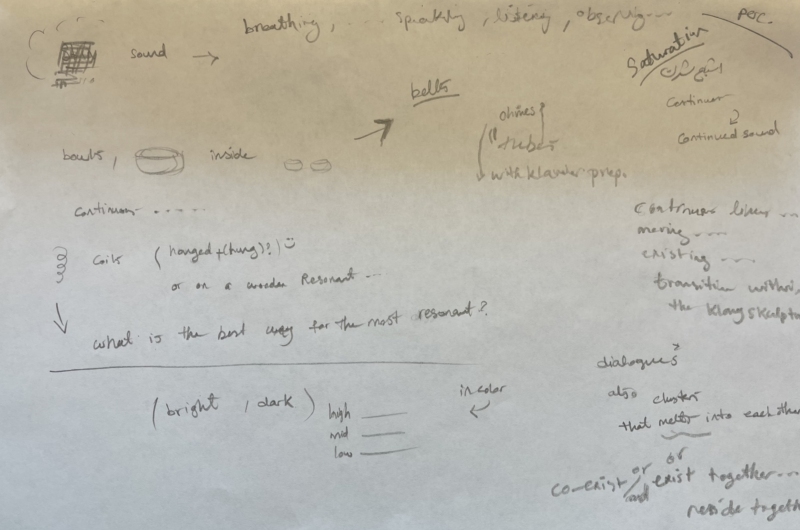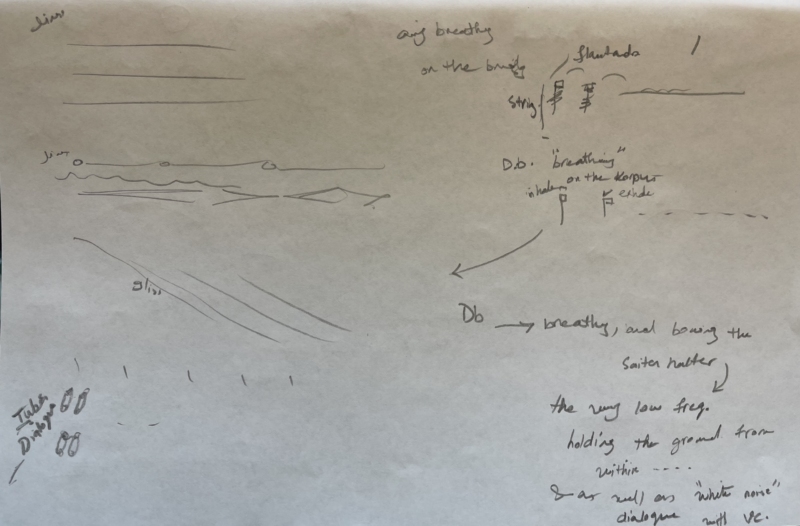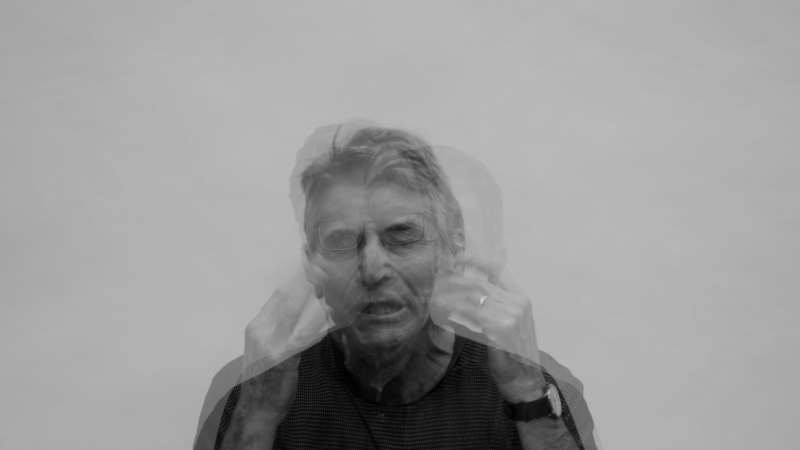READER: RESONANCES I
11.08.2023

Wukir Suryadi: “Madep Manteb” (2023) World Premiere – 20′
Diego Ramos Rodríguez (Arrangement)
Anahita Abbasi: “Situation XII – in our dwelling, we reside” (2023) World Premiere – 25′
Yiran Zhao: “fictional nonfiction” (2023) World Premiere – 30′
für 12 Musiker:innen, Video und Elektronik
Wukir Suryadi (Industrial Mutant, Gema Delay Synt Senyawa, Toraja Comb & Hat)
Ensemble Modern
Ilan Volkov (Musical Direction)
A project of Ensemble Modern and the International Music Institute Darmstadt (IMD) with the
participation of Ilan Volkov
Funded by the Federal Government Commissioner for Culture
and the Media. With the friendly support of the Ernst von Siemens Music Foundation and the
Ensemble Modern Patronatsgesellschaft e. V.

Dietmar Wiesner (Flute)
Christian Hommel (Oboe)
Hugo Queirós (Clarinet)
Olivia Palmer-Baker (Bassoon)
Saar Berger (Horn)
Mathilde Conley (Trumpet)
Uwe Dierksen (Trombone)
Jack Adler-McKean (Tuba)
Ueli Wiget (Piano)
Hermann Kretzschmar (Piano)
David Haller (Percussion)
Rainer Römer (Percussion)
Stefan Hussong (Accordion)
Jagdish Mistry (Violin)
Giorgos Panagiotidis (Violin)
Megumi Kasakawa (Viola)
Eva Böcker (Violoncello)
Esther Saladin (Violoncello)
Paul Cannon (Double Bass)
Ilan Volkov (Musical Direction)
Norbert Ommer (Sound Direction)
Lukas Nowok (Sound Engineering)

SITUATION XII – IN OUR DWELLING, WE RESIDE
This piece is the XII piece in the situation cycle.
Situation – definition:
📖 a set of circumstances in which one finds oneself
📖 a state of affairs; the way in which something is placed in relation to its surroundings
📖 relative position or combination of events and conditions at a particular moment
Dwelling – definition:
📖 a place/ shelter (such as a house) where people reside in it
📖 a structure where a person lives and sleeps
Examples:
📖 a single-family/multi-family dwelling
📖 sb’s permanent/temporary dwelling
📖 the erection of a single-story dwelling
Dwelling on something:
📖 to keep thinking or talking about something a lot of the time, stuck at it … reside in it
📖… “An ecological approach focuses on the individual‘s relationships with meaningful features of the environment; it emphasizes the intentionality of individual’s actions. The reciprocity of the environment and the individual is a central feature of an ecological approach. A dwelling is an individual’s primary anchor in the environment. It may serve many functions, such as shelter, privacy, security, control and status. From an ecological point of view the meaning of dwellings lies in these functional relationships between human beings and their dwellings … ”
(The Meaning of Dwellings: an Ecological Perspective by Henny Coolen)
Dwell time – examples:
In service:
📖 Dwell time is designed to allow service members a mental and physical break from combat and to give them time with their families.
📖 Dwell time varies by material and the size of the indications that are intended to be identified.
For trains:
📖 serving as en-route recovery time, improving reliability
Reside – definition:
📖 to live, have your home, or stay in a place
📖 have one’s permanent home in a particular place
Anahita Abbasi


WUKIR SURYADI ON “MANDEP MANTEB”
INSTRUMENTS BY WALTER SMETAK

INSTRUMENTS WUKIR SURYADI

YIRAN ZHAO ÜBER “FICTIONAL NONFICTION”
Everyone has their own different personal experience
Ten years, twenty years, thirty years, forty years
We have different dreams every day
We experience different realities every day
We are intertwined in different events every day
All our experiences are drowned in a flood of information
As memory fades, it slowly disappears
Like the grainy pixels of an old photo that cannot be refined
Becoming a mosaic of life
Like a weathered ancient city in the desert
Turning into a mote of dust in the sea of sand
And all we can do is look forward
One day our history will be written in the history books along with other histories as a drop of ink.
Thousands of years from now, someone may open a book in the archive.
Our story will become a word in it.
每个人都有自己不同的经历
十年 二十年 三十年 四十年
我们每天做着不同的梦
我们每天经历着不同的现实
我们每天交织在不同的事件中
所有的经历又淹没在信息之海
随着记忆衰退慢慢消失
像老照片看不清的低像素
变成生命中的一颗马赛克
像荒漠中风化的古城
变成沙海里的一粒尘
而我们能做的只有向前看
终有一日我们的历史将与其他历史一同汇成一滴墨 载入史册
千年后 也许会有人翻开档案馆的一本书
我们的故事便成了其中的只言片语
Yiran Zhao>/em>


Used archive photos in“fictional nonfiction”:
Andreas Etter: David Haller, Giorgos Panagiotidis
Barbara Fahle: Rainer Römer, Uwe Dierksen
Barbara Geis: Uwe Dierksen
Barbara Klemm: Dietmar Wiesner
Ingeborg Knigge: Eva Böcker, Rainer Römer
Stevie J. Sutanto: Megumi Kasakawa
Manu Theobald: Hermann Kretzschmar
Hanspeter Trefzer: Christian Hommel
Archiv Ensemble Modern: Jaan Bossier, Paul Cannon, Giorgos Panagiotidis,
Christian Hommel, Hermann Kretzschmar, Norbert Ommer, Johannes
Schwarz, Dietmar Wiesner
ARCHITECTS IN THE PALACE OF MEMORY
by Leonie Reineke
Archives are palaces of memory, built over long periods of time. They relieve the storage capacities of our heads and enrich our shared knowledge. They shape historiography, allowing images and narratives to take form. They are also instruments to decide what should remain in human memory. An exploration of the many rooms, passages, chambers and niches in such a palace – whether as focused research or mere browsing – can yield fascinating insights. Sometimes they uncover items long forgotten, undiscovered for decades. Sometimes subtle connections between historical events emerge, or unusual, perhaps fallacious interpretations of historical materials. Thus, the palace of memory quickly becomes a creative office for novelty. And suddenly the archive is no longer just about what is decidedly past, but also about the present and future – especially when one’s approach is not motivated by science, but has a clear artistic bent.
Chance finds, unsystematic searching, collecting by association, getting lost on a hundred side tracks – such roundabout methods are welcome when the point is to illustrate the autonomous nature of aesthetic practice. That is exactly the path chosen by the composers of the project “Funkensprünge” (literally, $ights of sparks) – an initiative associated with the surveying and digitization of Ensemble Modern‘s archive. Treasures from 40 years of the Ensemble’s history have become sources of inspiration for new works by these artists. Anahita Abbasi, Anda Kryeziu, Wukir Suryadi and Yiran Zhao have created four works for the stage: compositions which will have their world premieres during the 2023 Darmstadt Summer Course. Furthermore, Stefan Pohlit and Daniel Hensel created radio pieces commissioned by the station hr2-kultur. Neither was a direction for their research specified nor a special performance format, neither a manner of composing nor an ensemble size. Accordingly, the six resulting works are totally different, even though they all started with the same horizon of possibilities. Where musical creators usually make decisions about pitches, dynamics, tempi and playing techniques, here the first question was which archival materials they would use as their source of ideas and compositional material. Whether photographs, scores, programme books, audio cassettes, travel protocols, correspondence with luminaries of music history or other hand-written notes – the composers had access to the entire holdings of materials, on the basis of which they could develop new pieces together with members of Ensemble Modern.
Searching through an archive as the point of departure for composing is the opposite of facing a blank page of staves. Ideas are not developed into empty space, but rather “cut out” of a wealth of information and impressions – a process resembling the subtractive method of a sculptor. This is the comparison also drawn by the Iranian-born Anahita Abbasi as she discusses her ensemble piece “Situation XII – in our dwelling, we reside”. The first step in her work was reviewing lists of the complex holdings of the EM Archive, whereupon she chose individual scores, texts and recordings for closer study. “While doing so,” says the composer, “I stumbled across the Ensemble‘s collaboration with Frank Zappa. Originally, I had not planned to explore this chapter of the Ensemble’s history, but a fleeting glance at a score sparked my curiosity, so I studied it more closely. That is how I work in general: I always keep an ‘open ear’ for everything I perceive.” The materials discovered by Abbasi bear memories and a semantic potential, perhaps also one for association. She is examining all these characteristics like a scientist, in order to shape something new from these finds – “like an architect who has all the elements at her disposal and builds something new from them,” she says.
Not only the great variety of the holdings collected over the course of 40 years, but also the lacunae and blind spots of the archive are manifested in the new work for 12 musicians, video and electronics by Yiran Zhao. During her research, the composer, who was born in Qingdao, China, has trained her gaze on photographs of the Ensemble members and the details visible therein on the one hand. On the other, she has studied all those characteristics of the musician personalities which are not to be found in the archive: hidden character traits, gestures, variations in their facial expression, the cadence of their speech, personal moods and conversational atmospheres. Zhao has observed these aspects in her own interviews with the Ensemble‘s musicians, creating a pool of material of her own. “In our interviews,” says the composer, “we spoke about all kinds of things – from personal memories and unspectacular experiences of daily life to freely invented stories. This collection of stories forms the foundation of my piece: a mix of logical and illogical narrative strains, of reality and fake.” Another part of this docu-fictional piece is the private archive inside Yiran Zhao’s mind. For example, she refers to the work “The Second State” by the Chinese conceptual artist Geng Jianyi – a series of four large oil paintings showing the face of a man in various moments of laughter. “These huge faces are enormously expressive,” says Zhao. “They were at the back of my mind as I interviewed the Ensemble musicians. I wanted to know whether I could discover distinctive facial expressions, moods and special sides of their character in this conversational situation, aspects the official archive would not reveal to me.”
[…]
Installations […] play an [important] role in the output of Wukir Suryadi, a native of Indonesia. His artistic concepts occasionally include musical instruments he has devised himself, which are both sources of sound and sculptures. Therefore, Suryadi was interested in one of Ensemble Modern‘s projects in 2016/17, which was dedicated to the rediscovery of the composer and musician Walter Smetak – a Swiss-Brazilian artist who invented and constructed hundreds of instruments, from variations on European string instruments to mysterious, esoteric sculptures. “I find it intriguing,” says Suryadi, “to find out which unexpected results the combinations of these bizarre sources of sound with conventional instruments can yield.” For his piece “Madep Manteb”, the composer surveyed the entire 40-plus years of Ensemble Modern’s existence. He has interpreted this period using a model consisting of numeric proportions from the Javanese calendar. The result is a tripartite composition, subdivided into a phase of youth, a process of maturing and finally the transition to old age.
The fact that the development of an ensemble is here interpreted as a “life story” shows once again how freely the composers have treated the archive of Ensemble Modern as a source of material. And that is exactly what the project “Funkensprünge” stands for: the commissioned works are not about rehashing history, and certainly not about paying homage or obeisance to Ensemble Modern. Instead, they are about individuals looking into the future – even if everything starts with a rearview glance.

